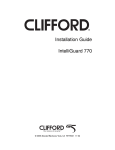Download Directed Electronics Clifford Programming instructions
Transcript
AvantGuard 5.1
➤Owner’s
Guide
limited lifetime consumer warranty
Directed Electronics ("Directed") promises to the original purchaser to repair or replace with a
comparable reconditioned model any Directed unit (hereafter the "unit"), excluding without
limitation the siren, the remote transmitters, the associated sensors and accessories, which
proves to be defective in workmanship or material under reasonable use during the lifetime of
the vehicle provided the following conditions are met: the unit was professionally installed and
serviced by an authorized Directed dealer; the unit will be professionally reinstalled in the vehicle in which it was originally installed by an authorized Directed dealer; and the unit is returned
to Directed, shipping prepaid with a legible copy of the bill of sale or other dated proof of purchase bearing the following information: consumer's name, telephone number and address;
the authorized dealers name, telephone number and address; complete product description,
including accessories; the year, make and model of the vehicle; vehicle license number and
vehicle identification number. All components other than the unit, including without limitation
the siren, the remote transmitters and the associated sensors and accessories, carry a one-year
warranty from the date of purchase of the same. This warranty is non-transferable and is automatically void if: the original purchaser has not completed the warranty card and mailed it within ten (10) days of the date of purchase to the address listed on the card; the unit's date code
or serial number is defaced, missing or altered; the unit has been modified or used in a manner contrary to its intended purpose; the unit has been damaged by accident, unreasonable
use, neglect, improper service, installation or other causes not arising out of defects in materials or construction. The warranty does not cover damage to the unit caused by installation or
removal of the unit. Directed, in its sole discretion, will determine what constitutes excessive
damage and may refuse the return of any unit with excessive damage. TO THE MAXIMUM
EXTENT ALLOWED BY LAW, ALL WARRANTIES, INCLUDING BUT NOT LIMITED TO EXPRESS
WARRANTY, IMPLIED WARRANTY, WARRANTY OF MERCHANTABILITY, FITNESS FOR PARTICULAR PURPOSE AND WARRANTY OF NON-INFRINGEMENT OF INTELLECTUAL PROPERTY, ARE
EXPRESSLY EXCLUDED; AND DIRECTED NEITHER ASSUMES NOR AUTHORIZES ANY PERSON
OR ENTITY TO ASSUME FOR IT ANY DUTY, OBLIGATION OR LIABILITY IN CONNECTION WITH
ITS PRODUCTS. DIRECTED DISCLAIMS AND HAS ABSOLUTELY NO LIABILITY FOR ANY AND ALL
ACTS OF THIRD PARTIES INCLUDING ITS AUTHORIZED DEALERS OR INSTALLERS. DIRECTED
SECURITY SYSTEMS, INCLUDING THIS UNIT, ARE DETERRENTS AGAINST POSSIBLE THEFT.
DIRECTED IS NOT OFFERING A GUARANTEE OR INSURANCE AGAINST VANDALISM, DAMAGE
OR THEFT OF THE AUTOMOBILE, ITS PARTS OR CONTENTS; AND HEREBY EXPRESSLY DISCLAIMS ANY LIABILITY WHATSOEVER, INCLUDING WITHOUT LIMITATION, LIABILITY FOR
THEFT, DAMAGE AND/OR VANDALISM. THIS WARRANTY DOES NOT COVER LABOR COSTS
FOR MAINTENANCE, REMOVAL OR REINSTALLATION OF THE UNIT OR ANY CONSEQUENTIAL
DAMAGES OF ANY KIND. IN THE EVENT OF A CLAIM OR A DISPUTE INVOLVING DIRECTED OR
ITS SUBSIDIARY, THE PROPER VENUE SHALL BE SAN DIEGO COUNTY IN THE STATE OF CALIFORNIA. CALIFORNIA STATE LAWS AND APPLICABLE FEDERAL LAWS SHALL APPLY AND GOVERN THE DISPUTE. THE MAXIMUM RECOVERY UNDER ANY CLAIM AGAINST DIRECTED SHALL
BE STRICTLY LIMITED TO THE AUTHORIZED DIRECTED DEALER'S PURCHASE PRICE OF THE
UNIT. DIRECTED SHALL NOT BE RESPONSIBLE FOR ANY DAMAGES WHATSOEVER, INCLUDING
BUT NOT LIMITED TO, ANY CONSEQUENTIAL DAMAGES, INCIDENTAL DAMAGES, DAMAGES
FOR THE LOSS OF TIME, LOSS OF EARNINGS, COMMERCIAL LOSS, LOSS OF ECONOMIC
© 2 0 0 6 d i re c t e d e l e c t ro n i c s — a l l r i g h t s re s e r v e d
i
OPPORTUNITY AND THE LIKE. NOTWITHSTANDING THE ABOVE, THE MANUFACTURER DOES
OFFER A LIMITED WARRANTY TO REPLACE OR REPAIR THE CONTROL MODULE AS DESCRIBED
ABOVE. Some states do not allow limitations on how long an implied warranty will last or the
exclusion or limitation of incidental or consequential damages. This warranty gives you specific legal rights and you may also have other rights that vary from State to State.
This product may be covered by a Guaranteed Protection Plan ("GPP"). See your authorized
Directed dealer for details of the plan or call Directed Customer Service at 1-800-876-0800.
Directed security systems, including this unit, are deterrents against possible theft. Directed is
not offering a guarantee or insurance against vandalism, damage or theft of the automobile,
its parts or contents; and hereby expressly disclaims any liability whatsoever, including without
limitation, liability for theft, damage and/or vandalism. Directed does not and has not authorized any person or entity to create for it any other obligation, promise, duty or obligation in
connection with this security system.
Make sure you have all of the following information from your dealer:
A clear copy of the sales receipt, showing the following:
z
Date of purchase
z
Your full name and address
z
Authorized dealer's company name and address
z
Type of alarm installed
z
Year, make, model and color of the automobile
z
Automobile license number
z
Vehicle identification number
z
All security options installed on automobile
z
Installation receipts
important! Please note that this manual was intended for US consumers
and therefore includes American phrases or words.
trademarks and copyrights
Bitwriter™, Clifford®, Code-Hopping™, Directed®, Doubleguard®, ESP™, FailSafe®, Ghost Switch™,
Learn Routine™, Nite-Lite®, Nuisance Prevention® Circuitry, NPC®, Revenger®, Silent Mode™, Soft
Chirp®, Stealth Coding™, Stinger®, Valet®, Vehicle Recovery System®, VRS®, and Warn Away® are
all Trademarks or Registered Trademarks of Directed Electronics.
ii
contents
limited lifetime consumer warran-
multiple event total recall . . . .16
ty . . . . . . . . . . . . . . . . . . . . . . . . . . .i
false alarm control technology
(FACT II) . . . . . . . . . . . . . . . . .16
trademarks and copyrights . . . . .ii
what is included
. . . . . . . . . . . . .3
important information . . . . . . . . .3
select siren sounds . . . . . . . . . . .17
diagnostics . . . . . . . . . . . . . . . . . .18
arming diagnostics . . . . . . . . .18
system maintenance . . . . . . . .4
disarming diagnostics . . . . . . .19
your warranty . . . . . . . . . . . . .4
arm/disarm diagnostic chart . .19
fcc/id notice . . . . . . . . . . . . . . .4
table of zones . . . . . . . . . . . .20
replacement remote controls . . .5
transmitter configurations . . . . . .6
transmitter functions . . . . . . . . . .7
standard configuration . . . . . . .7
anti-code grabbing (ACG) . . . . .20
high frequency . . . . . . . . . . . . . .21
smart power up II . . . . . . . . . . . .21
arming with transmitter . . . . . .9
power saver mode . . . . . . . . . . .21
arming without transmitter . . .9
programming . . . . . . . . . . . . . . .22
disarming . . . . . . . . . . . . . . . .10
cliffnet wizard installation soft-
disarming without a transmitter .
ware programming . . . . . . . .22
11
manual programming instruc-
remote siren silencing . . . . . .11
tions . . . . . . . . . . . . . . . . . . .23
transmitter chirp muting . . . .12
user selectable features . . . . .24
transmitter sensor disable . . .12
user selectable features descrip-
intellistart and smartwindows
tions - column one . . . . . . . . .25
sensor bypass . . . . . . . . . . . . .13
user selectable features descrip-
auxiliary channel bypass . . . . .13
tions - column two . . . . . . . .27
panic mode with smart door
user selectable features descrip-
locking . . . . . . . . . . . . . . . . . .13
tions - column three . . . . . . .29
disarm/valet mode . . . . . . . . .14
pin programming . . . . . . . . . . . .31
transmitter valet mode . . . . . .15
remote start . . . . . . . . . . . . . . . .32
one-time auto-arming bypass .15
low battery warning . . . . . . .15
© 2 0 0 6 d i re c t e d e l e c t ro n i c s — a l l r i g h t s re s e r v e d
remote start features . . . . . . .32
remote start do's and don'ts .33
1
remote start/engine shut down .
bypass blackjax temporarily . .39
34
blackjax off warning indicator 40
shortstop mode . . . . . . . . . . .35
sensor description section . . . . .41
low temperature/battery start 36
507M tilt sensor . . . . . . . . . . .41
retained accessory power . . . .36
adjusting the proximity sensor 41
diesel compatibility . . . . . . . .37
adjusting the omnisensor . . . .43
auto-immobilization feature . . .37
glossary of terms . . . . . . . . . . . . .46
auto-immobilization sequence 37
one-time valet feature . . . . . .38
blackjax feature . . . . . . . . . . . . .38
blackjax activation . . . . . . . . .38
blackjax deactivation sequence39
2
security & convenience expansions
48
health check . . . . . . . . . . . . . . . .49
what is included
z
z
z
z
z
z
z
z
z
z
z
z
Control module and harness
IntelliStart module and harness
Two five-button transmitters
Presentation envelope and quick reference card
Two window decal's
External antenna/receiver with harness
Pre-wired blue status LED
PlainView 2 Valet switch
515C Smart Self-Powered siren
Digital dual-zone proximity sensor
Digital dual-zone Omnisensor
507M Digital Tilt sensor
important information
Congratulations on the purchase of your state-of-the-art vehicle
security remote start system. It has been designed to provide years of
trouble-free operation. This system must be installed by an authorized
dealer. Installation of this product by anyone other than an authorized
dealer voids the warranty. As verification of authorization, all authorized dealers are provided with preprinted dealer certificates.
In order to maximize the use of this system, please review this owner's
guide carefully prior to using your system. You can print additional or
replacement copies of this owner’s guide by accessing the Clifford website at www.clifford.com.
© 2 0 0 6 d i re c t e d e l e c t ro n i c s — a l l r i g h t s re s e r v e d
3
system maintenance
The system requires no specific maintenance. Your transmitter is powered by two miniature 3V lithium batteries that will last approximately
one year under normal use. When the batteries weaken, operating
range will be reduced and the system will provide a low battery warning chirp indication when disarming.
your warranty
Your warranty registration must be completely filled out and returned
within 10 days of purchase. Your product warranty will not be validated if your warranty registration is not returned. Make sure you receive
the warranty registration from your dealer. It is also necessary to keep
your proof of purchase, which reflects that the product was installed by
an authorized dealer.
fcc/id notice
This device complies with Part 15 of FCC rules. Operation is subject to
the following two conditions: (1) This device may not cause harmful
interference, and (2) This device must accept any interference received,
including interference that may cause undesirable operation.
Changes or modifications not expressly approved by the party responsible for compliance could void the user's authority to operate this device.
Directed Electronics, Inc.
Tested to Comply
with FCC Standards
DRW 396
4
replacement remote controls
You can purchase replacement remote controls from your
Authorized Dealer or on-line at the following web site:
www.directedstore.com
Once you receive your new remote control, please refer to
instructions included on the remote packaging.
© 2 0 0 6 d i re c t e d e l e c t ro n i c s — a l l r i g h t s re s e r v e d
5
transmitter configurations
1
2
4
3
5
6
note: This manual describes the features and accessories that are
included with your system along with information about compatible
Clifford accessories that are not included. For a list of included accessories, please refer to the What Is Included section of this manual.
6
1.
LED Indicator
2.
Arm/Disarm Button
3.
Trunk Release Button
4.
Remote Start Button
5.
Silent Arm/Disarm Button
6.
Clifford G5 Button
transmitter functions
This system uses computer-based code learning to learn the transmitter buttons. This makes it possible to assign any transmitter button to
any system function. The transmitter initially comes programmed with
standard configuration, but may also be customized using the CliffNet
Wizard PC program. The buttons in all of the instructions in this manual correspond to a standard configuration transmitter.
standard configuration
Button
The arming, disarming, and panic function are controlled by this button.
Button
The trunk release or accessory output A is controlled by this button.
Button
warning! Operation of the remote start module
if the the vehicle starts in gear is contrary to its
intended mode of operation. Operating the
remote start system under these conditions may
result in property damage or personal injury.
Immediately cease the use of the unit and repair
or disconnect the installed remote start module.
Clifford will not be held responsible or pay for
installation or reinstallation costs.
Remote start is controlled by this button.
© 2 0 0 6 d i re c t e d e l e c t ro n i c s — a l l r i g h t s re s e r v e d
7
Button
Silent arm and disarm is controlled by this button.
Button, then
Button
Accessory B output is controlled by these buttons.
Button, then
Button
These buttons activate SmartWindows.
Button, then
Button
Accessory C output is controlled by these buttons.
Button twice, then
Button
These buttons activate remote valet.
Button twice, then
Button
These buttons disable the sensors.
Button twice, then
Button
These buttons enter safe start mode for manual transmission vehicles
and activate Autostart mode.
Button three times, then
Button
These buttons adjust the dual-zone radar sensor.
Button three times, then
Button
These buttons adjust the dual-zone omnisensor.
8
using your system
The buttons used in the instructions in this manual correspond to the
standard transmitter configuration. If your transmitter has been custom
configured, the icons on your transmitter buttons may not correspond
to the indicated functions.
arming with transmitter
You can activate, or arm, the system by pressing
on your trans-
mitter for one second. When the system arms, you will hear two short
siren sounds, or chirps, and see the parking lights flash twice. The LED
will begin to flash steadily. If the vehicle’s power door locks have been
connected to the system, the doors will lock.
While the system is armed, the LED status indicator will flash approximately once per second showing that the system is actively protecting
your vehicle. If you hear more than two chirps when arming, refer to
the Diagnostics section of this guide. These extra chirps confirm a malfunction autobypass.
arming without transmitter
The security system also can be programmed to arm itself without a
transmitter (called passive arming). If the system is programmed for
passive arming, it will automatically arm 30 seconds after the ignition
is turned off and the system sees you leave the vehicle by opening and
closing a door. The siren will chirp twice and the lights will flash twice
five seconds after the last door has been closed. The system is not actu-
© 2 0 0 6 d i re c t e d e l e c t ro n i c s — a l l r i g h t s re s e r v e d
9
ally armed at that point. The system arms and the doors lock (if connected and programmed for passive locking) at 30 seconds, but the
siren will not chirp. The early chirps provide you with a 25-second
warning prior to arming.
note: If any protected entry point (a door or a switch-protected trunk or
hood) is open, the system will not passively arm. Additionally, each
time a protected entry is triggered during the arming countdown, the
30-second countdown starts over.
When armed, your vehicle is protected as follows:
z
The LED will flash as a visible theft deterrent.
z
Light impacts will trigger the Warning Zone signal. When
triggered, the siren will sound for a few seconds.
z
Heavy impacts will trigger the system. The triggered
sequence is 30, 60, or 90 seconds of constant siren sounding and flashing parking lights.
z
If a protected entry (door, hood, or trunk) is opened, the system
will immediately trigger the siren and flash the parking lights.
z
Digital dual zone radar sensor will protect the interior of the vehicle and it’s contents with an invisible perimeter of protection.
z
The 507M tilt sensor will trigger the system if an attempt is
made to steal the vehicle by towing.
disarming
To disarm the system, press
. You will hear a chirp and the parking lights will flash once. If the power locks are connected to the system, the doors will unlock. If the siren chirps three times when disarming, refer to the Diagnostics section of this guide. This is called Tamper
Alert. If the siren is active when the system is disarmed you will hear
two chirps but the system is not disarmed. (Refer to the Remote Siren
10
Silencing section of this guide.) However, if the alarm completes the full
trigger cycle when disarmed you will hear three chirps.
disarming without a transmitter
This feature allows you to disarm the system without the transmitter
should it be lost, damaged, or disabled. In order to disarm without a
transmitter, you must have the vehicle’s ignition key, know where the
PlainView 2 Valet switch is located, and have the PIN code. Be sure to
check with the installer for the location of the PlainView 2 Valet switch.
Please refer to the Disarm/Valet Mode section of this guide for instructions to enter the pin code.
remote siren silencing
This system offers remote siren silencing. Remote siren silencing is a feature that makes it possible to silence and reset the system when it is
triggering without disarming the system. If the system is triggered and
the siren has been sounding, press
on the transmitter to stop the
trigger and return the unit to the armed state. This prevents you from
disabling the system should you wish to silence it without visually
checking the vehicle. After resetting the system, press
again to
disarm the system.
© 2 0 0 6 d i re c t e d e l e c t ro n i c s — a l l r i g h t s re s e r v e d
11
transmitter chirp muting
To temporarily turn off the arm or disarm chirps, use transmitter chirp
muting. Simply press
on the transmitter, and the confirmation
chirp(s) will be eliminated for that one operation only. The parking
lights will flash to confirm the arm/disarm command. If you want the
arm/disarm chirps turned off permanently, please refer to the UserSelectable Features section of this guide.
transmitter sensor disable
To temporarily disable a sensor input, arm the system, press
and then
twice
. The lights will flash four times and all sensor warn
away zones are bypassed. Press the buttons again; the lights flash four
times and both warn away and full trigger sensor zones are bypassed
until the system is disarmed. This can be performed anytime the system
is armed.
12
1.
Arm the system.
2.
Press
3.
The lights will flash four times; all warn away zones are now
bypassed.
4.
Transmit the sensor bypass channel again.
5.
The lights will flash four more times; the sensor warn away
and full trigger zones are now bypassed.
6.
The sensor zones will reset when disarmed.
twice and then
.
intellistart and smartwindows sensor bypass
When the system sees a command to start the vehicle via the
Intellistart, it bypasses all sensors and will continue to bypass these sensors until the remote start shuts down.
When the system sees a SmartWindows command for up or down
operation, the unit will automatically bypass all sensors until the windows complete their operation.
auxiliary channel bypass
All sensor will be bypassed while a pulsed or timed auxiliary output
channel is active.
panic mode with smart door locking
If you are threatened in or near your vehicle, you can attract attention
by triggering the system with your transmitter! Just press
for
two seconds to enter Panic Mode. The siren will sound and the parking lights will flash for the programmed duration. If the ignition is on,
the doors will lock; if the ignition is off, the doors will unlock. To stop
Panic Mode at any time press
on the transmitter again.
© 2 0 0 6 d i re c t e d e l e c t ro n i c s — a l l r i g h t s re s e r v e d
13
disarm/valet mode
Entering your pin code using the PlainView 2 Valet switch allows you
to disarm the system or enter valet mode without using the transmitter. In valet mode, the security system will not arm, even with the transmitter, but all convenience functions (door locks, trunk release, etc.)
will continue to work normally.
To disarm or enter Valet Mode:
1. Turn the ignition on.
2. Enter PIN code (factory setting is 2 - this
procedure is described later in this manual).
3. After the last digit of the pin code is entered:
a. To disarm the system: press and release
b. To enter valet mode: Press and hold
.
for
three seconds.
The LED status indicator will light steadily when Valet Mode has been
entered.
To exit Valet Mode:
1. Turn the ignition on.
2. Enter PIN code.
3. After the last digit press
for one second.
The LED status indicator will turn off when
Valet Mode has been exited.
14
transmitter valet mode
To enter or exit Valet Mode, press
twice and then
. The LED
status indicator will light solid when Valet Mode is entered, or will turn
off when Valet Mode is exited.
one-time auto-arming bypass
This will bypass the auto arm feature once only.
1.
With the key, turn the ignition on, then off within two seconds.
2.
The siren will chirp once to confirm auto arming bypass.
3.
The system will not auto arm.
note: The system will revert to normal auto arming when the system
sees the ignition on for at least three seconds.
During auto arming bypass the system will not roll up the windows if
SmartWindows is connected, and the accessory output will not autoactivate when using the remote to arm the system.
low battery warning
When the transmitter battery is low, the system will generate a lowpitched tone when disarmed.
© 2 0 0 6 d i re c t e d e l e c t ro n i c s — a l l r i g h t s re s e r v e d
15
multiple event total recall
This will report the last eight system triggers.
1.
Press and hold
of the PlainView 2 Valet switch.
2.
While still holding
release the button.
3.
The LED will start to blink to indicate the most recent trigger
and proceed down to the eighth trigger. If fewer than eight
triggers are stored in memory, the LED will blink continuously until the system is armed/disarmed using the transmitter
or the ignition is turned on. For more information, please
refer to the Table of Zones section of this guide.
, arm and disarm the system, then
false alarm control technology (FACT II)
Your system offers FACT
II, a feature that prevents annoying
repetitive trigger sequences due to a faulty sensor or environmental
conditions such as thunder, jackhammers, airport noise, etc.
Here’s how it works: The alarm triggers three times. If the same sensor is
triggering the alarm and the first and the third triggers are within 60 min-
II will interpret this pattern of triggers as false
alarms. After the third trigger, FACT II ignores, or bypasses, that sensor
utes of each other, FACT
(along with any other sensors sharing the same zone) for 60 minutes.
If the bypassed sensor tries to trigger the system while it is being
bypassed, the 60-minute bypass period will start over. This ensures that
a sensor that continually triggers will remain bypassed.
16
Doors are covered by FACT
II differently; if the alarm is triggered by an
open door for three full cycles, the doors will be bypassed until the trigger ceases. FACT
II is programmable. See the Programming Options
section of this guide.
note: Arming and disarming the system does not reset this function! The
only way to reset a bypassed zone is for 60 minutes or to turn on the ignition. If testing your system, it is important to remember that the FACT II programming can cause zones to be bypassed and appear to stop working.
If you wish to clear the FACT II memory, turn the ignition key on.
select siren sounds
To customize siren sounds, please refer to the selectable siren sounds
feature in the User Selectable Features grid. Once in programming
mode, press
on the transmitter to begin playback of the avail-
able sounds.
Press
on the PlainView 2 Valet switch while playing the desired
sound to add that sound; press
while playing the desired sound to
delete that sound.
note: Additional tones can be accessed through the CliffNet Wizard.
© 2 0 0 6 d i re c t e d e l e c t ro n i c s — a l l r i g h t s re s e r v e d
17
diagnostics
The microprocessor at the heart of your security system is constantly
monitoring all of the switches and sensors that are connected to it. It
detects any faulty switches and sensors and prevents them from disabling the entire system. The microprocessor will also record and report
any triggers that occurred during your absence.
arming diagnostics
If the system is armed while an input is active (door open, sensor triggering, etc.) the unit will chirp as per the arm/disarm diagnostic chart
(next page). This is called Bypass Notification.
The security system will ignore the input that was active when the system was armed, until the input goes away. Three seconds later the system will monitor that input normally.
18
1.
If a door is open the siren will chirp 4 times – 5 seconds after
the arming chirps.
2.
If a sensor is active the siren will chirp 4 times – 10 seconds
after the arming chirps.
3.
If the hood or trunk is open, the siren will chirp 4 times on
arming.
disarming diagnostics
Extra disarm chirps are the Tamper Alert. If three chirps are heard when
disarming, the system was triggered in your absence. If three chirps are
heard, the LED status indicator will indicate which zone was involved
when you turn the ignition on (see the Table of Zones section). The system will retain this information in its memory. Refer to the Multiple
Event Total Recall section of this guide.
arm/disarm diagnostic chart
Action
Chirps
Light Flashes
Description
Arm
2
2
System armed
Arm
4
4
System armed with hood/
trunk active and bypassed
(zones 5 and 6)
Arm
2 (5 sec.) 4
2 (5 sec.) 4
System armed with door
active and bypassed (zone 4)
Arm
2 (10 sec.) 4
2 (10 sec.) 4
System armed with sensor
active and bypassed zones
1, 2, 3, and 8
Disarm
1
1
System disarmed
Disarm
3
3
System disarmed with
tamper alert
© 2 0 0 6 d i re c t e d e l e c t ro n i c s — a l l r i g h t s re s e r v e d
19
table of zones
The zone number is the number of LED flashes used by the system to
identify a specific input. The standard input assignments are listed
below, along with spaces to write in any optional sensors or switches
you have had installed. If the Warning Zone response is triggered, the
LED will not report it.
Zone - Number
of LED Flashes
Description
1
Proximity sensor
2
Omnisensor
3
Mux 1 trigger - for optional
sensors
4
Door switch trigger
5
Instant trigger - trunk
6
Instant trigger - hood
7
Ignition trigger
8
Mux 2 trigger - for optional
sensors
9
BlackJax activation
10
Power interrupt
Dealer-Installed
Options
anti-code grabbing (ACG)
This unit features Anti-Code Grabbing (ACG) with Random Code
Encryption. This means the receiver and transmitters each use a mathematical formula called an algorithm to change their code each time
the transmitter is used. This technology has been developed to increase
the security of the unit. The control unit knows what the next code
should be.
20
high frequency
Your system transmits and receives at 433 MHz. This provides a cleaner
spectrum with less interference and a more stable signal.
smart power up II
This security system will store its current state to non-volatile memory.
If power is lost and then reconnected the system will recall the stored
state from memory. This means if the unit is in Valet Mode and the battery is disconnected for any reason, such as servicing the car, when the
battery is reconnected the unit will still be in Valet Mode. This applies
to all states of the system including arm, disarm, and Valet Mode.
power saver mode
Your system will automatically enter Power Saver Mode while armed or
in Valet Mode, after a period of time in which no operation has been
performed. This lowers the current draw on the vehicle's battery and
prevents the system from draining the battery. Power Saver Mode takes
over under the following conditions:
© 2 0 0 6 d i re c t e d e l e c t ro n i c s — a l l r i g h t s re s e r v e d
21
z
Power Saver when the system is armed: After the system has
been armed for 48 hours, the LED will flash at half its normal rate, decreasing the system's current draw.
z
Power Saver in Valet Mode: When the system enters Valet
Mode the LED illuminates steadily. If the vehicle is not used
(ignition is not turned on) for a period of one hour while the
system is in Valet Mode, the LED will shut off. If the system
remains in Valet Mode, the LED will come back on and restart
the 1 hour timer the next time the ignition is turned off.
programming
cliffnet wizard installation software programming
Cliffnet Wizard provides access to all available system features and
some that are not available when manually programming with the
Valet switch. Cliffnet Wizard is compatible with Microsoft Windows
2000/ME/XP/NT so most programming operations can be accomplished
by pointing and clicking with a mouse. This eliminates the need for programming grids and lengthy programming sequences. For a complete
guide to system programming using the Cliffnet Wizard refer to the
Cliffnet Wizard help menu. The software is available for download at
www.clifford.com.
22
manual programming instructions
Be sure to document changes by taking note of all feature changes
made in programming mode.
To enter the User Selectable Features programming:
1.
Ignition on - Turn the ignition to the run position or start the
engine.
2.
Enter PIN - Enter the factory preset PIN code 2 by pressing
on the PlainView 2 Valet switch twice, then
once.
note: If the factory preset PIN has been changed, the new PIN must
be entered.
3.
Hold/Chirp/Release - After entering the PIN code, press and
hold
until a chirp is heard and the LED turns on, then
release the button. You have now entered the feature selection position of the User Selectable Features grid.
4.
Column select - Press
the same number of times as the
desired column. After a pause the siren will chirp the same
number of times as the selected column for confirmation.
5.
Feature select - Press
the same number of times as the
desired feature. The siren will chirp with each press. The feature can now be changed using the remote control.
6.
Feature change - Press
on the transmitter. If the system chirps once, the feature has just turned off; if the system chips twice, the feature has just turned on. If the feature has more than two settings, continue pressing
on the transmitter to toggle through the settings.
To advance to the next feature in the same column, press
the same number of times as the desired feature within 60
seconds; to change a feature in a different column begin at
step 4 by entering the column number first and then the row
© 2 0 0 6 d i re c t e d e l e c t ro n i c s — a l l r i g h t s re s e r v e d
23
number.
note: Refer to the Feature Descriptions sections of this guide for important notes and descriptions of the system features and programming.
7.
Exit programming - To exit programming mode turn the ignition off or wait 60 seconds without pressing the PlainView 2
Valet switch. The siren will chirp three times to indicate programming mode has been exited.
user selectable features
Then
Press
First
Press
Add new remote
(autolearn)
Set PIN code
(default = 2)
New remote learn
arm/disarm only
Auto (passive)
arm off/on
Chirps
off/on/quiet
Select siren
sounds
FACT II off/on
New remote learn
accessory A channel
New remote learn
accessory B channel
Auto lock
off/ignition/rpm
Remote valet
off/on
New remote learn
silent mode
Auto unlock
off/ignition
Entry delay off/on
New remote learn
remote valet
Auto (passive)
arm and lock
off/on
Siren duration
30/60/90
Reset to default
(except transmitter
and valet code)
Panic off/on
New remote learn
remote start*
Second unlock
off/on
Autostart setting*
New remote learn
(off/battery only/ accessory C channel
temp only/
battery and temp)
BlackJax off/on
Clear all remotes
Not used
New remote learn
window down/vent**
* This feature is only available with IntelliStart connected.
** This feature is only available with optional SmartWindows connected.
24
user selectable features descriptions - column one
add new remote (auto learn)
Auto-learn new five-button remote controls to the system in the standard button configuration. Once you have entered the feature, press
on the transmitter until you hear a confirmation chirp.
auto (passive) arm - off/on
z
Off: The transmitter must be used to arm the system.
z
On: When the system sees the ignition turn off and the last
protected entry (door, hood, or trunk) close, it will begin a
30-second countdown before arming itself. After the first
five seconds, you will hear two chirps and the lights will
flash. The system will arm 25 seconds later.
chirps - off/on/quiet
z
Off: Chirps will not sound when arming/disarming the system.
z
On: Chirps will sound when arming/disarming the system.
z
Quiet: Chirps will sound when arming/disarming the system
but at a lower volume than normal.
auto lock - off/ignition/rpm
z
Off: The doors will not lock automatically.
z
Ignition: The doors will automatically lock three seconds after
the ignition is turned on unless a door is open at that time.
z
Rpm: The doors will lock when the system sees the engine
reach a preprogrammed RPM.
© 2 0 0 6 d i re c t e d e l e c t ro n i c s — a l l r i g h t s re s e r v e d
25
auto unlock - off/ignition
z
Off: The doors will not automatically unlock when the ignition is turned off.
z
Ignition: The doors will automatically unlock as soon as the
ignition is turned off.
auto (passive) arm and lock - off/on
z
Off: The doors will not lock when the system passively arms.
z
On: The doors will lock when the system passively arms. This
feature only applies when passive arming is programmed on.
siren duration - 30/60/90
z
The system will sound the alarm for the programmed duration (30/60/90 seconds) during an alarm trigger or when the
system is put into panic mode.
second unlock - off/on
z
Off: Second unlock output is pulsed at the same time as the
unlock output when the system is disarmed.
z
On: Second unlock output is active when the arm/disarm
button is pressed within 10 seconds of disarming the system.
note: The second unlock can be installed by your dealer. Please note
that extra parts and labor may be required.
26
user selectable features descriptions - column two
set pin code
This feature allows the setting of the user's personal PIN code. For more
information, please refer to the PIN Programming section of this guide.
select siren sounds
The individual sounds the siren produces during an full trigger alarm can
be customized for owner recognition of an alarm trigger. For more information, please refer to the Select Siren Sounds section of this guide.
note: Sounds 7 through 15 available using CliffNet Wizard.
fact II off/on
z
Off: The alarm will respond to sensor inputs indefinitely
without bypassing.
z
On: The alarm will bypass for 60 minutes if a sensor is triggered three times within a one hour period.
remote valet off/on
z
Off: The alarm can not be put into valet mode with the
remote control.
z
On: The alarm can be put into valet mode with the remote
control.
entry delay off/on
z
Off: There is no entry delay when armed. The system will
trigger instantly when a door is opened.
z
On: If the system has passively armed, it will not trigger for
15 seconds after a door is opened allowing the user to enter
the vehicle and disarm the system via the PlainView 2 Valet
switch.
© 2 0 0 6 d i re c t e d e l e c t ro n i c s — a l l r i g h t s re s e r v e d
27
reset to default settings
z
All system settings (except PIN and remote programming) in
the User Programming grid will be reset to their default factory setting as indicated in bold lettering.
z
Press the arm/disarm button of the TX; the siren will chirp
twice as confirmation.
panic off/on
z
Off: The panic feature is not available.
z
On: The panic feature is available.
auto start setting - off/battery only/temp only/battery and temp
z
This feature is only available with the IntelliStart option.
z
Off: The vehicle will not autostart.
z
Battery: The vehicle will only autostart when the car battery
gets low.
z
Temperature: The vehicle will only autostart at a preset low
temperature.
z
Battery and temperature: The vehicle will autostart with a
low car battery or low temperature.
note: Temperature and battery calibration and settings can be made
only with the Cliffnet Wizard.
blackjax off/on
28
z
Off: The system cannot enter BlackJax mode.
z
On: The system will enter BlackJax mode when triggered.
user selectable features descriptions - column three
The features in this column pertain to programming individual transmitter channels in custom configurations. Following is an explanation
of the features.
arm/disarm only
The remote control channel programmed into this feature will arm/disarm the system only.
note: When programming a new remote control to custom configuration a channel must first be programmed to this feature before programming the remaining channels.
accessory a output
The transmitter channel programmed into this feature will activate the
accessory output.
accessory b output
The transmitter channel programmed into this feature will activate the
accessory output.
silent mode
The transmitter channel programmed into this feature will arm/disarm
the system, but the siren will not chirp.
remote valet
The transmitter channel programmed into this feature will make the
system enter/exit valet mode.
© 2 0 0 6 d i re c t e d e l e c t ro n i c s — a l l r i g h t s re s e r v e d
29
remote start
z
This feature is only available with IntelliStart connected.
z
The transmitter channel programmed into this feature will
activate or shut down the Intellistart remote start system.
window control
z
This feature is only available with SmartWindows connected.
z
The transmitter channel programmed into this feature will activate the vent or roll down feature of the SmartWindows system.
accessory c output
The transmitter channel programmed into this feature will activate the
accessory output.
clear all remotes
30
z
This feature will erase all remote codes from the system
memory. This feature is convenient for erasing any transmitters that have been lost, stolen, or incorrectly programmed
into the system.
z
After entering this feature press any button on the transmitter; the siren will chirp to indicate that all transmitters have
been erased from memory.
pin programming
A PIN code can have one to four digits; each digit can be from 0-9.
note: A PIN code cannot begin with a zero.
Programming Procedure
1.
Enter the feature location in the installer programming grid.
2.
Immediately press and release
switch.
3.
Select each digit by pressing
of the PlainView 2 Valet
1-9 times, and then press
to enter the number into the system. To enter a zero,
press
only.
To program a PIN code of 1032:
1.
Press and release
hear one chirp.
once and
once. You will
3.
Press and release
once. You will not hear a chirp
after programming a zero.
5.
Press and release
three times, and then press
once. You will hear three chirps.
6.
Press and release
two times, and then press
once. You will hear two chirps.
4.
Wait for two siren chirps after a five second pause or five
seconds after the last digit has been entered if using less
than four digit code number.
5.
Turn off the ignition; the siren will chirp three times.
6.
The programming mode is now exited.
© 2 0 0 6 d i re c t e d e l e c t ro n i c s — a l l r i g h t s re s e r v e d
31
PIN Code Confirmation Procedure
Begin this procedure within 15 seconds of finishing the programming
sequence or the new code will not be set.
1.
Turn on the ignition.
2.
Enter the new PIN code.
3.
Press and hold
for three seconds.
z
LED turns on: New PIN code is learned and programming is complete.
z
LED stays off: New PIN code is not learned and the system reverts to the old PIN code. Repeat the programming sequence.
remote start
remote start features
32
z
Remotely start your car’s engine from hundreds of feet away.
z
Automatically performs extensive pre-start safety checks.
z
Automatic cold weather cranking for hard-start conditions.
z
Activates all preset accessories such as the heater or AC.
z
Monitors RPM and shuts down the engine if problems are
detected.
z
Clifford security system remains armed throughout.
z
Automatically bypasses triggered security sensors.
z
Automatically shuts down the engine if the alarm sounds.
z
Auto shutdown after 30 minutes if left unattended.
z
Prevents the starter from engaging if the driver turns the
ignition key too far.
z
ShortStop lets you remove the key and arm the alarm for a
brief errand while the engine continues to idle.
z
Selectable low temp autostart warm up for very cold weather.
z
Selectable low battery autostart recharging.
z
Extended accessory power after ignition is turned off.
z
Automatic transmission compatibility.
note: this product must be installed by an authorized Directed dealer
in accordance with the instructions supplied. It is intended for automobiles with a 12V battery and a gas- or diesel-powered, electronic fuelinjected engine. Your authorized Directed dealer can correct any
wiring problems, and if necessary, can return any malfunctioning component to Directed Electronics for repair/replacement under the warranty terms and conditions noted in this manual.
remote start do's and don'ts
Do's
z
Park in a well ventilated area if you should plan on remote
starting your vehicle.
z
Engage the parking brake at all times.
z
Place the transmission in PARK before shutting the engine off.
z
Preset your comfort controls according to the condition
desired for the vehicle interior when remote start is activated.
z
Always make sure the vehicle has sufficient petrol.
© 2 0 0 6 d i re c t e d e l e c t ro n i c s — a l l r i g h t s re s e r v e d
33
Don'ts
z
DON'T remote start your vehicle or engage Shortstop or Autostart
modes in an enclosed area such as a garage or car port.
z
DON'T allow children access to your remote control.
z
DON'T engage remote start or Shortstop or Autostart modes
when children or pets are present in the vehicle.
z
DON’T remote start the vehicle when someone is in front or
behind the vehicle.
remote start/engine shut down
To remotely start your vehicle, press
for one second.
When starting:
z
The lights will flash 2 times as confirmation to start.
z
The ignition and preset accessories will start and run for the
programmed run time.
z
The lights will stay on as a visual indicator that the engine is
running.
To remotely shut off your vehicle, press the
button of the remote
control for 1 second. The engine will shut off and the lights will go out.
Drive vehicle after remote starting:
After your vehicle has been remotely started, you can enter and drive
away without having to restart.
z
34
Disarm the security section of your system as you normally
would.
z
Enter the vehicle without stepping on the brake or moving
the shift lever.
z
Insert your key into the ignition and turn to the run position.
z
Step on the brake, the remote start will turn off and the
engine will stay running.
z
You are ready to drive.
shortstop mode
Shortstop mode is a convenience feature that allows the remote start
to keep the engine running while you run a brief errand. In Shortstop
mode, the security section of your system will operate normally should
you want to activate it.
To activate shortstop mode:
z
Park the vehicle, place the shifter into park, and engage the
hand brake. Place the shifter into the neutral position if it is
a manual transmission.
z
Without pressing the brake pedal, press the
button of
your remote control. The lights will flash 2 times as confirmation.
z
Turn the ignition off and remove the keys from the ignition
switch. The engine will continue to run.
z
Exit the vehicle, arm the security system and attend to your
business. The engine will run for the programmed run time.
© 2 0 0 6 d i re c t e d e l e c t ro n i c s — a l l r i g h t s re s e r v e d
35
low temperature/battery start
Your remote start system can automatically start your vehicle if the interior reaches a pre-programmed low temperature setting or if the battery charge level drops too low. Both these settings can be calibrated
and set using the Cliffnet Wizard. It is recommended that you have
your installer calibrate and set the start time intervals if you intend to
use this feature.
To activate autostart mode:
z
Arm the security section of your system.
z
Transmit the Autostart command, the
button twice,
then the
button once. The lights will flash 2 times as
confirmation of Autostart mode.
z
The remote start will monitor the temperature and battery
levels and start at the programmed settings and intervals.
retained accessory power
The remote start section of this system will, after turning off the ignition, keep the accessory power of the vehicle on for 5 minutes or until
the vehicle door is opened. This is very convenient if you forgot to roll
up windows or just want to listen to the radio.
36
diesel compatibility
The system will activate the engine’s glow plugs for the necessary duration before starting via either a timer delay or through a direct connection
to your vehicle’s glow plug indicator (may require optional parts or wiring).
auto-immobilization feature
Auto-immobilization is a feature designed for maximum security; it
activates the UltraSecure Immobilization circuitry automatically.
auto-immobilization sequence
1.
Turn ignition off or disarm alarm.
2.
After 30 seconds the systems Immobilization circuits activate
and engage the starter and ignition interrupt.
3.
LED blinks at ½ normal speed.
Disarming auto-immobilization
To disarm auto-immobilization when active, follow any of the
sequences listed below.
z
Turn ignition on and press the arm/disarm button.
z
Arm the alarm and then disarm the alarm.
z
Turn the ignition on and enter the system valet/PIN code.
© 2 0 0 6 d i re c t e d e l e c t ro n i c s — a l l r i g h t s re s e r v e d
37
one-time valet feature
This feature allows the system to be put in valet mode only until the
next time the ignition is turned on.
ON: Valet mode will be exited every time the ignition is turned on.
OFF: Valet mode will only be exited by using the valet switch or
the remote control.
blackjax feature
Clifford's exclusive BlackJax feature provides a safe and effective means
of recovering your vehicle after a carjacking by monitoring the door
input, brakes, and engine speed. Simply get out of the vehicle and let
the thief drive away.
blackjax activation
After the vehicle is at a safe distance BlackJax will activate the siren and
brake lights to draw attention to the vehicle. When BlackJax sees the
vehicle slow down or stop, the UltraSecure Immobilizer circuit shuts off
the engine, stranding the thief and vehicle. At this time your transmitter will not operate the system, only you can turn off the BlackJax by
entering your secret PIN through the PlainView 2 valet switch.
38
note: If the driver accidently exits the vehicle and triggers the blackjax
feature, the siren will sound 5 chirps after 20 seconds. The driver then
has 20 seconds to enter the pin code to deactivate the blackjax feature.
When BlackJax is programmed ON, BlackJax sequence will begin every
time the ignition is turned on and must be turned off by entering your
PIN code. It will then activate again while driving when triggered.
note: BlackJax can be turned off by entering PIN code at any time.
blackjax deactivation sequence
To deactivate BlackJax turn the key on and then enter the PIN code at
any time.
bypass blackjax temporarily
This feature allows you to easily bypass BlackJax activation when another person drives your vehicle that should not know your PIN code. (IE:
valet parking, auto service dept.)
Bypass BlackJax temporarily
1.
Turn ignition on.
2.
Enter PIN code. Do not enter valet or programming mode.
3.
Within 10 seconds press
© 2 0 0 6 d i re c t e d e l e c t ro n i c s — a l l r i g h t s re s e r v e d
.
39
4.
Siren chirps 1 time as confirmation of BlackJax bypassed.
5.
Turn Ignition Off, siren chirps 3 times as confirmation of exiting programming.
note: If ignition remains on after entering PIN code and no action for 10
seconds, unit will automatically exit programming mode without chirps.
To return to normal BlackJax Operation
1.
Turn ignition on.
2.
Enter Pin code.
3.
Within 10 seconds press
4.
Siren chirps 2 times as confirmation of BlackJax active.
5.
Turn ignition off, siren chirps 3 times as confirmation of exiting programming.
.
note: If ignition remains on after entering PIN code and no action for 10
seconds, unit will automatically exit programming mode without chirps.
blackjax off warning indicator
Each time the ignition is turned off when BlackJax is bypassed the LED
will blink 10 times as warning that the BlackJax has been temporarily
bypassed.
40
sensor description section
507M tilt sensor
This sensor detects when the vehicle is being raised in an attempt to
either remove the wheels/tires or tow the vehicle. This sensor is capable of learning the vehicle’s initial angles of vertical and horizontal inclination each time the vehicle is parked.
adjusting the proximity sensor
It is recommended that adjustments be performed away from fluorescent lighting, large metal structures, or confined areas that can affect
the sensor field. The alarm will exit adjustment mode automatically 60
seconds after the last adjustment signal from the transmitter and revert
to its previous settings.
note: You MUST exit using the ARM/DISARM button after programming to lock in the new settings!
The proximity sensor field takes one to two minutes to settle after
entering adjustment mode, so begin adjusting the sensor within 45
seconds and adjust it slowly so it has time to settle. After two minutes
you will have a consistent field during adjustment testing. Each zone
has 32 settings that are indicated by chirps that raise and lower in frequency as adjustments are made. Total adjustment time for this sensor
should be five minutes or less.
© 2 0 0 6 d i re c t e d e l e c t ro n i c s — a l l r i g h t s re s e r v e d
41
Read the following instructions thoroughly for a full understanding of
how to properly adjust this sensor.
1.
Disarm system
2.
Transmit Channel 16 (Press
time)
3.
4.
5.
42
3-times then
1-
z
The LED will turn on and the siren will chirp 1-time.
z
Primary (full trigger) zone adjustment has now been
entered.
z
Primary zone can now be adjusted.
Adjusting Primary Zone
z
Press
of the remote control to increase sensitivity.
z
Press
of the remote control to decrease sensitivity.
z
The sensor Primary zone can be tested at any time during adjustment and will generate 1 siren chirp each
time the zone is activated.
Press
to adjust Warn-Away zone
z
Siren chirps 1 time.
z
Warn-away Zone adjustment has now been entered.
z
Warn-away Zone can now be adjusted.
Adjust Warn-away Zone
z
Press
to increase sensitivity.
z
Press
to decrease sensitivity.
z
The sensor Warn-away zone can be tested at any time
during adjustment and will generate 1 siren chirp each
time the zone is activated.
6.
Press
of the remote control to return to Primary zone
adjustment and lock in Warn Away zone setting.
z
Siren chirps 2 times.
z
Primary zone can now be re-adjusted as described in
step 3.
z
Or press
again to lock in primary zone setting
and exit programming mode.
z
The siren will chirp 3 times when sensor adjustment
mode has been exited.
z
Auto-Scroll for adjusting sensitivity - press and
hold
or
to increase or decrease sensitivity setting several levels rapidly.
adjusting the omnisensor
The Omnisensor is designed for ease of adjustment by the user and to
give the ultimate in impact detection without the possibility of false
triggers that are common with less sophisticated sensor.
While adjusting this sensor it is required that you strike the vehicle with
the amount force that is desired for the system to trigger.
note: DO NOT strike window glass or flat sheet metal panels that can
dent easily. It is recommended that you only strike the metal pillars
between the windows, they are structurally sound enough not to dent.
ONLY strike the pillars using the heel of your hand, it is more than sufficient for the sensor to distinguish this as a theft attempt.
1.
Disarm system
2.
Transmit Channel 15 (Press
time).
z
3 times then
1
The LED will turn on and the siren will chirp 1 time.
© 2 0 0 6 d i re c t e d e l e c t ro n i c s — a l l r i g h t s re s e r v e d
43
z
3.
4.
5.
6.
44
Sensor test and adjustment mode is entered.
To test Primary (full trigger) zone.
z
Press
z
Siren will chirp 2 times.
z
Hit vehicle.
z
Siren chirps 1 time if hit hard enough to activate sensor.
of the remote control.
To adjust Primary zone
z
Press
z
Siren chirps 2 times.
z
Sensor adjustment mode is entered.
z
Hit vehicle at the desired level of impact.
z
Sensor adjusts itself to the force of Hit.
z
Siren chirps 1 time as confirmation of adjustment.
z
Press
of the remote control.
of the remote control to lock adjustment.
To adjust Warn-away zone
z
Press
z
Siren chirps 1 time.
z
Warn-away zone adjustment is entered.
.
To test Warn-away zone
z
Press
z
Siren will chirp 2 times.
z
Hit vehicle.
z
Siren chirps 1 time if hit hard enough to activate sensor.
.
7.
8.
Adjust Warn-away zone
z
Press
z
Siren chirps 2 times.
z
Sensor adjustment mode is entered.
z
Hit vehicle at the desired level of impact.
z
Sensor adjusts itself to the force of Hit.
z
Siren chirps 1 time as confirmation of adjustment.
z
Press
Press
.
to lock adjustment.
to re-enter Primary zone adjustment
z
Siren chirps 2 times.
z
Primary zone can now be re-adjusted as described in
step 4.
z
Or press
z
The siren will chirp 3 times when sensor adjustment
mode has been exited.
again to exit programming mode.
note: You must wait 15 seconds after arming for the omnisensor to
become active.
© 2 0 0 6 d i re c t e d e l e c t ro n i c s — a l l r i g h t s re s e r v e d
45
glossary of terms
507M Tilt sensor: This sensor detects when the vehicle is being raised in
an attempt to either remove the wheels/tires or tow the vehicle. This
sensor is capable of learning the vehicle’s initial inclination angles each
time the vehicle is parked.
Control Unit: The "brain" of your system. Usually hidden underneath
the dash area of the vehicle. It houses the microprocessor which monitors your vehicle and controls all of the system's functions.
Input: A physical connection to the system. An input can be provided
by a sensor, pinswitch or through an existing system in the vehicle, such
as ignition or courtesy lights.
LED: Blue light mounted somewhere in the vehicle. It is used to indi-
cate the status of your system. It is also used to report triggers and
faults in the system or sensors.
Omnisensor: A dual-zone learning impact sensor.
PlainView 2 Valet Switch: A small two-button switch mounted some-
where inside the vehicle. It is used to override the alarm when a transmitter is lost or damaged, or to enter or exit Valet mode.
Power Window Control: Automatic power window control is provided
with the SmartWindows system.
46
Proximity Sensor: This is a sensor mounted in the vehicle that is
designed to protect the interior and its contents.
Siren: Noise generating device usually installed in the engine compart-
ment of the vehicle. It is responsible for generating the "chirps" you
hear, as well as the six tones you hear while the alarm is triggered.
Transmitter: Hand-held transmitter which operates the various func-
tions of your system.
Trigger or Triggered Sequence: This is what happens when the alarm
goes off or trips. The triggered response of your system consists of the
siren sounding and parking light flashing for the programmed duration.
UltraSecure Immobilizer: A feature on the module which prevents the
vehicle’s engine from operating whenever the system is armed. The
vehicle is never prevented from running when the system is disarmed,
in Valet mode, or loss of power.
Warning Zone Response: Lighter impacts or movement close to the vehi-
cle will generate the Warning Zone response. It consists of a warning
siren blast or beep.
Zone: A zone is a separate input that the alarm can recognize as
unique. Each input to the system is connected to a particular zone. Two
or more inputs often share the same zone.
© 2 0 0 6 d i re c t e d e l e c t ro n i c s — a l l r i g h t s re s e r v e d
47
security & convenience expansions
Here we have listed only some of the many expansion options available. Please contact your dealer for a complete list of all the options
available to you.
Backup Battery: The 520T keeps the system armed, triggers the alarm and
keeps the immobilization circuits active if main battery power is disconnected.
Glass Tamper Sensor: Metal on glass, glass cracking, and breaking glass
each produce distinctive acoustic signatures. The 506T glass tamper sensor uses a microphone to pick up sounds, and then analyzes them with
proprietary acoustic software to determine if the glass has been struck.
Power Trunk Release: The
button can operate a factory power
release for the vehicle’s trunk or hatch. (An optional relay may be required.) If the factory release is not power activated, the Directed®'s
522T trunk release solenoid can often be added.
Power Window Control: Automatic power window control is provided
with the SmartWindows system.
48
health check
Directed Electronics recommends you return to your installing Clifford dealer to have your system checked for correct operation. The first check is due
one year after the installation date and at yearly intervals thereafter.
note: There may be a small charge incurred for this service.
© 2 0 0 6 d i re c t e d e l e c t ro n i c s — a l l r i g h t s re s e r v e d
49
The company behind this system is Directed Electronics.
Since its inception, Directed Electronics has had one purpose, to provide consumers with
the finest vehicle security and car stereo products and accessories available. The recipient of
nearly 100 patents and Innovations Awards in the field of advanced electronic
technology, Directed is ISO 9001 registered.
Quality Directed Electronics products are sold and serviced throughout North America
and around the world.
Call (800) 274-0200 for more information about our products and services.
Directed® is committed to delivering world-class quality products and services
that excite and delight our customers.
Vista, CA 92081
www.directed.com
© 2006 Directed Electronics - All rights reserved
G919640 11-06
































































